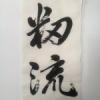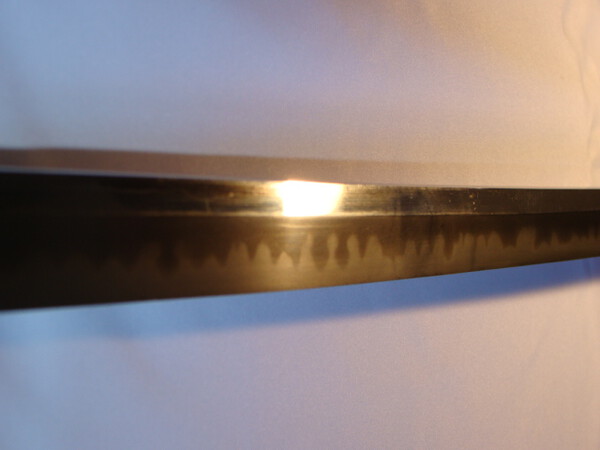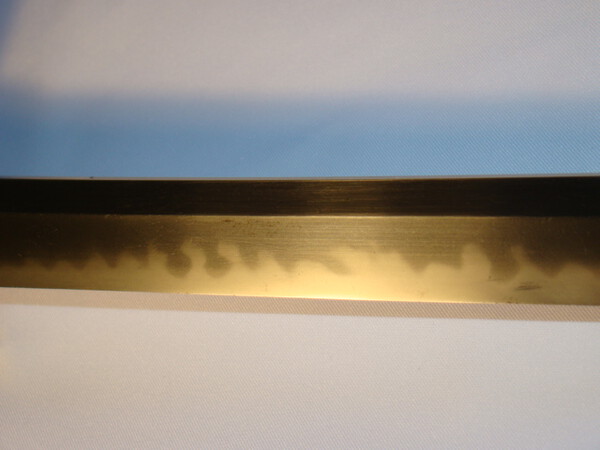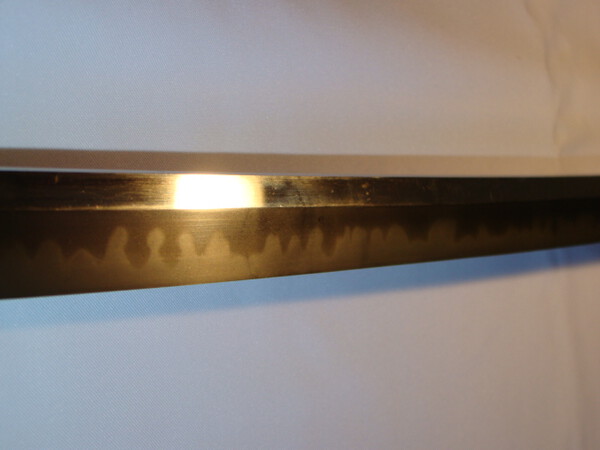-
Posts
150 -
Joined
-
Last visited
-
Days Won
1
Everything posted by Robert Mormile
-
Chishiki Two of these prints are signed Toyohara Kunichika although I believe they were all made by Toyohara Kunichika. That red aniline dye wasn’t commonly used across broad swaths of prints before about 1875. (Utagawa Kuniyoshi died in 1861) The signature on the two are: 國周筆 Kunichika Hitsu (Fude) Meaning by the brush of Kunichika Enjoy your prints, Robert
-
Randy, Just an FYI. I went through many volumes specializing in Koto swords and wasn’t able to locate that Tomonari signature anywhere. It seems to be an example that was not widely known/published. The books I went through are as follows: Imamura Oshigata Yumei Koto Taikan Nihonto Juyo Bijutsuhin Zenshu Bizen Den Taikan Meibutsu Token Koto Meisaku Shu *and others… Also, after consulting the Juyo Token To Bunrui Mokuroku (my copy issue date 1999) there were no Tomonari blades that passed Juyo with this specified length. Based on the oshigata, the signature is worthy of further study. Wonder where the sword is today… Robert
-
Mariusz, Perhaps 綱廣 Tsunahiro. RM
-
Hi guys I think either it’s of the following: 三原住正定 Mihara Jyu Masasada Or 三原住正安 Mihara Jyu Masayasu Both worked in the late 1500’s. Best of luck, Robert
-
Rick: Oops. I took 三十六歌仙 for 三十古歌仙 so Sanjyuroku Kasen or 36 top poets / songwriters. (Must have been the Jamison talking...) . Here is a complete listing: https://ja.wikipedia.org/wiki/%E4%B8%89%E5%8D%81%E5%85%AD%E6%AD%8C%E4%BB%99 Steve: For the most part this stuff was mass produced for the Western market. That small plate has an indentation for a cup in the center which makes it a saucer to a demitasse set. My guess is that the bowel is too large to be a chawan, just decorative. Thank you. Robert
-
Hi Rick: This is 20th century Kutani-yaki porcelain. The title is 三十古歌仙 (Sanjyu Kokasen) which means 30 top poets / songwriters. Kaga in northwestern Japan is home to this type of porcelain. Thanks for sharing. Robert
-
Luca: To be quite honest, it looks to me like a modern cast fake. Most swords during WWII were carried as a tachi (edge down) so the notch doesn’t make sense to me. (The dragon would be upside down) I think the notch was put there to hide an imperfection in the recent casting. There appear to be bubbles around the mei on the seppa-dai… Emptor Cavete Robert
-
Hi Bob: Nice looking bowl. It’s Oribe-Yaki from modern-day Gifu Prefecture. Definitely 20th Century. Google Oribe and you can learn more. It will be difficult translate the script but I can see 牡丹 (Pronounced Botan) which refers to a peony like flower in Japan and 雪の (Yuki no) which literally means “the snow’s”. In any event, its poetry that dances along with that fanciful rim. Thanks for sharing. Robert
-
Brian: The name of the soldier is as follows: 古林 貞三郎 Kobayashi Sadasaburo (It also could be Teisaburo but I don’t think so.) I can only make out the last two characters of the place name which are: 椎尾 Shiio The other characters are obscured or missing from the top of the paper tag. I think the name would be a good place to start research and use the address information to confirm his identity if that is what you are trying to do. Best Wishes, Robert
-

Please Help With Gold Inscription On Nakago
Robert Mormile replied to Edward G's topic in Translation Assistance
Edward: The kanji reads "Aoe". It's the name of a school. Seems like a fine sword. Best of luck. Robert -
Bojan: Difficult to tell but what does the temperline look like? Does it seem that the blade itself was affected by the electrolysis? If we could pin down a region then maybe we could deduce a date range... A photo of the overall sugata of the blade would help assign an approximate date. Thank you. Robert
-
Hi Mark: Looks like: Motoiwa Bushu Jyu Chikashige 本岩武州住周重 Alternatively, the Motoiwa might be Motowaka 本若武州住周重 I can’t seem to find an old town name as above but most of these Chikashige smiths were settled around Hachioji in western Tokyo then called Bushu. They followed the Shitahara tradition in late koto and early Shinto times. That “chikara” times three character is actually an old variant of the “shu” character so we can understand this as Bushu. Love to see some pics of the blade… Robert
-
Hi Marcello: Mei reads: Minamoto Moritoshi 源守俊 Do you have any pics of the blade to share with fellow-members? Enjoy the season, Robert
-
Jon: Looks like: 長州住友之 Choshu Jyu Tomoyuki Missed you at Chicago… Robert
-
Klaus: I had a blade with a wooden habaki with a crack in it. It worked just fine for the 12 or so years I had the blade for. (Just recently sold.) Just as with a soft metal habaki, as long as you are careful with returning the blade to the saya it should be just fine. Personally, I would be concerned that fumes from even dried glue would tarnish the blade. Like most things in this field, it is best to just leave it alone. Robert
-
Jason: 特殊鋼以井戸秀俊作 Tokushuko Motte Ido Hidetoshi Saku I will leave the Seki question to others. Gotta run. Robert
-

Samurai And Retainer Painting. What Motive?
Robert Mormile replied to Jesper's topic in General Nihonto Related Discussion
Jesper: Signs like that were often used to make some sort of legal proclamation or public announcement. Agreed on the era depicted but not sure who or what incident in history it would be referring to. It looks like mulberry paper to me. Sorry I couldn’t be more helpful. The mystery continues. Robert -
Grev: Well the hamon and sugata are plausible for Hizen Tadayoshi but difficult to say any more. The script is written in cursive “sosho” so it adds to the level of difficulty of reading it, for me. In any event, a handsome wakizashi. The masterful Tadayoshi works that I have seen tend to have a wide and bright habuchi; I don't see that in this example. This may be a later work of the school if, indeed, of Hizen Tadayoshi lineage. Perhaps some of the more knowledgeable members could provide some additional comments. I think some information on the boshi might enable that discussion. Robert
-
John: One alternative might be to take an existing sword bag to the tailor in town and s/he make it for you. I found that the best pattern for a sword bag was an existing sword bag. You can choose the material but have it finished professionally. My guy charged $40 per unit and were excellent. Just an idea. Robert
-

My Idea Of A Sword Room
Robert Mormile replied to Pete Klein's topic in General Nihonto Related Discussion
Pete: I sat in that chair on the right in November of 2013 and fell in love with a Fukuoka Ichimonji which was Juyo Bijutsu Hin and have never quite recovered from the experience. It was like a rainbow. The owner and his wife (Kawashima I think it was) were quite nice and showed me some great ko-tosho tsuba. The wife is an absolute tsuba expert trained by her father. Special place. Robert -
Grev: If I can see through the glare properly it reads as follows: Hizen (no) Kuni Tadayoshi 肥前国忠吉 Second line looks like its length: 長さ二尺七寸八分 Which if accurate would be quite long… (over 84 cm) I must be missing something. Either blurry characters or not matching the blades length... Enjoy the weekend. Robert
-
James: They are available for sale each year at the NBTHK to be purchased. There is a variety of issuances of the available at the NBTHK website however not a complete set so to speak. 第59回重要刀剣等図譜 (An Issue Title) http://www.touken.or.jp/shop/index.html The shipping off to the right hand side is for domestic Japan shipping. There are some Juyo as well as Tokubetsu-Juyo available for sale now. (I’m not sure when this was last updated as 2010 seems to be the last issue listed) If you don’t have the first 10 issues they are a great reference: (Grey just happens to have a set now) http://www.japaneseswordbooksandtsuba.com/store/books/b867-juyo-token-nado-zufu-vol-1-10-complete As you can see they run more or less $200 per year. A complete set would be a rather scares commodity although they do come up from time to time. It might be easiest to purchase a bunch the next time you are at the sword museum OR have someone local ship them to you and then pick up missing editions a few at a time. *I think by contacting the museum you would be able obtain the latest edition. (Perhaps via the NBTHK-AB) **Never heard of any translations. Hope this helps. Robert
-
John: I actually see more of a gunome as opposed to midare but the characteristic you are looking for are the bulbous ends of the hamon. In some examples, they almost look like large drips. Here is an example that I owned years ago that dated to late koto times that illustrates a typical Kanefusa. Robert
-
Art: I haven’t made any kind of exhaustive study but it looks good enough to shinsa. I would have looked longer but my neck was starting to hurt looking at the upside down photo. Tadatsuna is a rather big name so there was significant interest in faking his signature. And keep in mind that during the Edo Period forgers were very competent. Question is really more about the blade itself. What are its characteristics and do they match known examples of Tadatsuna’s work? An accurate assessment would be to look at the blade first and then cross-reference it against 10 or more signatures by the smith over time. Look at what is common among all signatures see if those features can be found in yours. Better photos will get you a more educated opinion. Best of Luck, Robert http://www.iidakoendo.com/info/item/a475.htm





